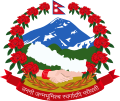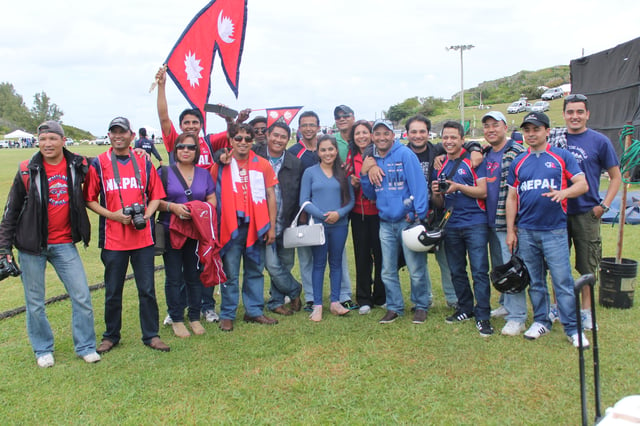Nepal
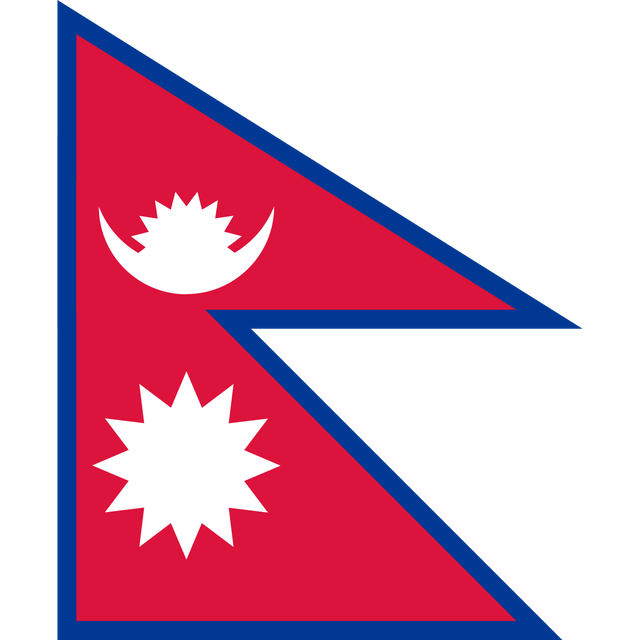
Nepal

Federal Democratic Republic of Nepal
| |
|---|---|
Motto:जननी जन्मभूमिश्च स्वर्गादपि गरीयसी(Sanskrit) Mother and motherland are greater than heaven(English) | |
 | |
 | |
| Capital and largest city | Kathmandu 28°10′N 84°15′E [316] |
| Official languages | Nepali |
| Recognised national languages | All languages used in Nepal |
| Ethnic groups (2011) | Ethnic demography
|
| Religion | 81.3% Hinduism 9% Buddhism 4.4% Islam 3% Kirant 1.4% Christianity 0.4% Animism 0.5% Irreligion[12][13] |
| Demonym(s) | Nepali (official), Nepalese |
| Government | Federal parliamentary republic |
• President | Bidhya Devi Bhandari |
• Vice President | Nanda Kishor Pun |
• Prime Minister | Khadga Prasad Sharma Oli |
• Chief Justice | Cholendra Shumsher Jung Bahadur Rana |
• Assembly Chairman | Ganesh Prasad Timilsina |
• House Speaker | Krishna Bahadur Mahara[14] |
| Legislature | Federal Parliament |
• Upper house | National Assembly |
• Lower house | House of Representatives |
| Formation | |
• Kingdom declared | 25 September 1768[15] |
• State declared | 18 May 2006[16] |
• Republic declared | 28 May 2008 |
• 2015 Constitution | 20 September 2015 |
| Area | |
• Total | 147,181 km2(56,827 sq mi) (93rd) |
• Water (%) | 2.8 |
| Population | |
• 2016 estimate | 28,982,771[17] (48th) |
• 2011 census | 26,494,504[18] |
• Density | 180/km2(466.2/sq mi) (62nd) |
| GDP(PPP) | 2018 estimate |
• Total | $84 billion[19] |
• Per capita | $2,842[19] |
| GDP(nominal) | 2018 estimate |
• Total | $27 billion[19] |
• Per capita | $919[19] |
| Gini(2010) | medium |
| HDI(2017) | medium · 149th |
| Currency | Nepalese rupee Rs (Nepali:रू) (NPR) |
| Time zone | UTC+05:45(Nepal Standard Time) |
| DST not observed | |
| Driving side | left |
| Calling code | +977 |
| ISO 3166 code | NP |
| Internet TLD | .np |
Nepal (Nepali: नेपाल [neˈpal]), officially the Federal Democratic Republic of Nepal,[22] is a landlocked country in South Asia. It is located mainly in the Himalayas, but also includes parts of the Indo-Gangetic Plain. With an estimated population of 26.4 million, it is 48th largest country by population and 93rd largest country by area.[18][23] It borders China in the north and India in the south, east and west while Bangladesh is located within only 27 km (17 mi) of its southeastern tip and Bhutan is separated from it by the Indian state of Sikkim. Nepal has a diverse geography, including fertile plains,[24] subalpine forested hills, and eight of the world's ten tallest mountains, including Mount Everest, the highest point on Earth. Kathmandu is the capital and the largest city. Nepal is a multiethnic country with Nepali as the official language.
The name "Nepal" is first recorded in texts from the Vedic period of the Indian subcontinent, the era in ancient India when Hinduism was founded, the predominant religion of the country. In the middle of the first millennium BCE, Gautama Buddha, the founder of Buddhism, was born in Lumbini in southern Nepal. Parts of northern Nepal were intertwined with the culture of Tibet. The centrally located Kathmandu Valley is intertwined with the culture of Indo-Aryans,[25] and was the seat of the prosperous Newar confederacy known as Nepal Mandala. The Himalayan branch of the ancient Silk Road was dominated by the valley's traders. The cosmopolitan region developed distinct traditional art and architecture. By the 18th century, the Gorkha Kingdom achieved the unification of Nepal. The Shah dynasty established the Kingdom of Nepal and later formed an alliance with the British Empire, under its Rajput Rana dynasty of premiers. The country was never colonized but served as a buffer state between Imperial China and British India.[26][27][28] Parliamentary democracy was introduced in 1951, but was twice suspended by Nepalese monarchs, in 1960 and 2005. The Nepalese Civil War in the 1990s and early 2000s resulted in the proclamation of a secular republic in 2008, ending the world's last Hindu monarchy.[29]
The Constitution of Nepal, adopted in 2015, affirms Nepal as a secular federal parliamentary republic divided into seven provinces.[30] Nepal was admitted to the United Nations in 1955, and friendship treaties were signed with India in 1950 and the People's Republic of China in 1960.[31][32] Nepal hosts the permanent secretariat of the South Asian Association for Regional Cooperation (SAARC), of which it is a founding member. Nepal is also a member of the Non Aligned Movement and the Bay of Bengal Initiative. The military of Nepal is the fifth largest in South Asia; it is notable for its Gurkha history, particularly during the world wars, and has been a significant contributor to United Nations peacekeeping operations.
Federal Democratic Republic of Nepal
| |
|---|---|
Motto:जननी जन्मभूमिश्च स्वर्गादपि गरीयसी(Sanskrit) Mother and motherland are greater than heaven(English) | |
 | |
 | |
| Capital and largest city | Kathmandu 28°10′N 84°15′E [316] |
| Official languages | Nepali |
| Recognised national languages | All languages used in Nepal |
| Ethnic groups (2011) | Ethnic demography
|
| Religion | 81.3% Hinduism 9% Buddhism 4.4% Islam 3% Kirant 1.4% Christianity 0.4% Animism 0.5% Irreligion[12][13] |
| Demonym(s) | Nepali (official), Nepalese |
| Government | Federal parliamentary republic |
• President | Bidhya Devi Bhandari |
• Vice President | Nanda Kishor Pun |
• Prime Minister | Khadga Prasad Sharma Oli |
• Chief Justice | Cholendra Shumsher Jung Bahadur Rana |
• Assembly Chairman | Ganesh Prasad Timilsina |
• House Speaker | Krishna Bahadur Mahara[14] |
| Legislature | Federal Parliament |
• Upper house | National Assembly |
• Lower house | House of Representatives |
| Formation | |
• Kingdom declared | 25 September 1768[15] |
• State declared | 18 May 2006[16] |
• Republic declared | 28 May 2008 |
• 2015 Constitution | 20 September 2015 |
| Area | |
• Total | 147,181 km2(56,827 sq mi) (93rd) |
• Water (%) | 2.8 |
| Population | |
• 2016 estimate | 28,982,771[17] (48th) |
• 2011 census | 26,494,504[18] |
• Density | 180/km2(466.2/sq mi) (62nd) |
| GDP(PPP) | 2018 estimate |
• Total | $84 billion[19] |
• Per capita | $2,842[19] |
| GDP(nominal) | 2018 estimate |
• Total | $27 billion[19] |
• Per capita | $919[19] |
| Gini(2010) | medium |
| HDI(2017) | medium · 149th |
| Currency | Nepalese rupee Rs (Nepali:रू) (NPR) |
| Time zone | UTC+05:45(Nepal Standard Time) |
| DST not observed | |
| Driving side | left |
| Calling code | +977 |
| ISO 3166 code | NP |
| Internet TLD | .np |
Etymology
Before the unification of Nepal, the Kathmandu valley was known as Nepal Rajya.[1] The precise origin of the term Nepāl is uncertain. A number of plausible theories are found in religious as well as academic texts. Nepal appears in ancient Indian literary texts dated as far back as the fourth century BC. However, an absolute chronology can not be established, as even the oldest texts may contain anonymous contributions dating as late as the early modern period. On the other hand, academic attempts to provide a plausible theory suffer from lack of a complete picture of history, and insufficient understanding of linguistics or of relevant Indo-European and Tibeto-Burman languages.[34]
According to Hindu mythology, Nepal derives its name from an ancient Hindu sage called Ne, referred to variously as Ne Muni or Nemi. According to Pashupati Purana, as a place protected by Ne, the country in the heart of the Himalayas came to be known as Nepal.[2] According to Nepal Mahatmya,[3] Nemi was charged with protection of the country by Pashupati.[35] According to Buddhist mythology, Manjushri Bodhisattva drained a primordial lake of serpents to create the Nepal valley and proclaimed that Adi-Buddha Ne would take care of the community that would settle it. As the cherished of Ne, the valley would be called Nepal.[36] According to Gopalarajvamshavali, the genealogy of ancient Gopala dynasty compiled circa 1380s, Nepal is named after Nepa the cowherd, the founder of the Nepali scion of the Abhiras. In this account, the cow that issued milk to the spot, at which Nepa discovered the Jyotirlinga of Pashupatinath upon investigation, was also named Ne.[34]
Norwegian Indologist Christian Lassen proposed that Nepala was a compound of Nipa (foot of a mountain) and -ala (short suffix for alaya which means abode), and therefore, Nepala meant "abode at the foot of the mountain". He considered Ne Muni to be a fabrication.[37] Indologist Sylvain Levi found Lassen's theory untenable but had no theories of his own, only suggesting that either Newara is a vulgarism of sanskritic Nepala, or Nepala is Sanskritisation of the local ethnic.[38] Levi's view has some support in later works.[39][40][41] The idea that Nepal is a polished form of Newar, the name of the indigenous people of Kathmandu valley, may be gaining support,[34] but it leaves the question of etymology unanswered. One theory proposes that Nepa is a Tibeto-Burman stem consisting of Ne (cattle) and Pa (keeper), which alludes to the fact that early inhabitants of the valley were Gopalas (cowherds) and Mahispalas (buffalo-herds).[34] Suniti Kumar Chatterji thought that 'Nepal' originated from Tibeto-Burman roots- Ne, of uncertain meaning (as multiple possibilities exist), and pala or bal, whose meaning is lost entirely.[42]
History
Ancient Nepal
Nepal is mentioned in the late Vedic Atharvaveda Pariśiṣṭa and in the post-Vedic Atharvashirsha Upanishad.[44] Nepal is also mentioned in Hindu texts such as the Narayana Puja and the regional text "Nepal Mahatmya" which claims to be a part of Skanda Purana.[44] The Gopal Bansa were likely one of the earliest inhabitants of Kathmandu valley.[45] The earliest rulers of Nepal were the Kiratas (Kirata Kingdom), peoples often mentioned in Hindu texts, who ruled Nepal for many centuries. Various sources mention up to 32 Kirati kings ruling over 16 centuries.[46]
Around 500 BCE, small kingdoms and confederations of clans arose in the southern regions of Nepal. From one of these, the Shakya polity, arose a prince who later renounced his status to lead an ascetic life, founded Buddhism, and came to be known as Gautama Buddha (traditionally dated 563–483 BCE).[47] By 250 BCE, the southern regions had come under the influence of the Maurya Empire of North India and later became a vassal state under the Gupta Empire in the 4th century CE.[48] In Samudragupta's Allahabad Pillar it is mentioned as a border country.
The kings of the Lichhavi dynasty have been found to have ruled Nepal after the Kirat monarchical dynasty. The context that "Suryavansi Kshetriyas had established a new regime by defeating the Kirats" can be found in some genealogies and Puranas. It is not clear yet when the Lichhavi dynasty was established in Nepal. According to the opinion of Baburam Acharya, the prominent historian of Nepal, Lichhavies established their independent rule by abolishing the Kirati state that prevailed in Nepal around 250 CE.
The Licchavi dynasty went into decline in the late 8th century, and was followed by a Newar or Thakuri era. Thakuri kings ruled over the country up to the middle of the 12th century CE; King Raghav Dev is said to have founded the ruling dynasty in October 869 CE.[49] King Raghav Dev also started the Nepal Sambat.[50]
Medieval Nepal
In the early 12th century, leaders emerged in far western Nepal whose names ended with the Sanskrit suffix malla ("wrestler"). These kings consolidated their power and ruled over the next 200 years, until the kingdom splintered into two dozen petty states. Another Malla dynasty beginning with Jayasthiti emerged in the Kathmandu valley in the late 14th century, and much of central Nepal again came under a unified rule. In 1482, the realm was divided into three kingdoms: Kathmandu, Patan, and Bhaktapur.[51]
Unification of Nepal
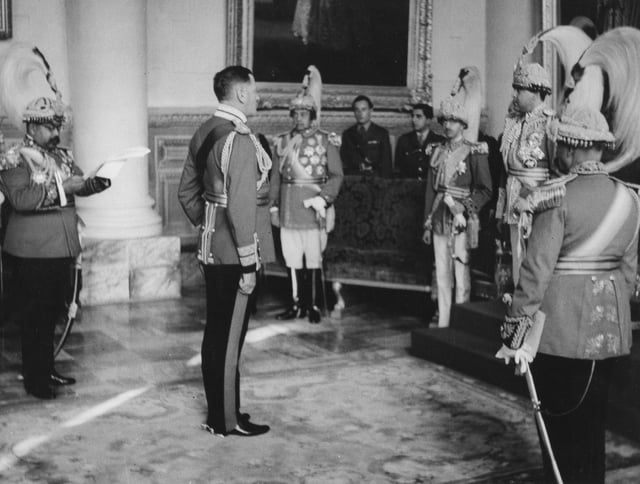
King Tribhuvan giving an audience to British general Claude Auchinleck at the royal palace in Kathmandu, 1945
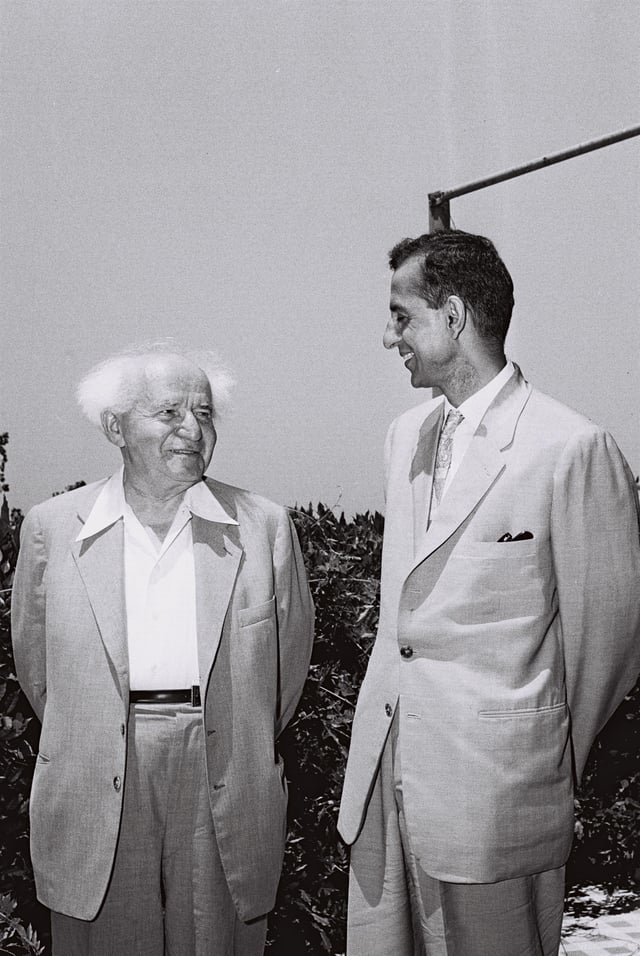
Prime Minister of Israel David Ben-Gurion and Prime Minister of Nepal B. P. Koirala
In the mid-18th century, Prithvi Narayan Shah, a Gorkha king, set out to put together what would become present-day Nepal. He embarked on his mission by securing the neutrality of the bordering mountain kingdoms. After several bloody battles and sieges, notably the Battle of Kirtipur, he managed to conquer the Kathmandu Valley in 1769. A detailed account of Prithvi Narayan Shah's victory was written by Father Giuseppe, an eyewitness to the war.[52]
The Gorkha control reached its height when the North Indian territories of the Kumaon and Garhwal Kingdoms in the west to Sikkim in the east came under Nepalese control. A dispute with Tibet over the control of mountain passes and inner Tingri valleys of Tibet forced the Qing Emperor of China to start the Sino-Nepali War compelling the Nepali to retreat and pay heavy reparations to Peking.
Rivalry between the Kingdom of Nepal and the East India Company over the control of states bordering Nepal eventually led to the Anglo-Nepali War (1815–16). At first, the British underestimated the Nepali and were soundly defeated until committing more military resources than they had anticipated needing. Thus began the reputation of Gurkhas as fierce and ruthless soldiers. The war ended in the Sugauli Treaty, under which Nepal ceded recently captured lands as well as the right to recruit soldiers. Madhesis, having supported the East India Company during the war, had their lands gifted to Nepal.[53]
Rana autocratic regime
Factionalism inside the royal family led to a period of instability. In 1846, a plot was discovered revealing that the reigning queen had planned to overthrow Jung Bahadur Kunwar, a fast-rising military leader. This led to the Kot massacre; armed clashes between military personnel and administrators loyal to the queen led to the execution of several hundred princes and chieftains around the country. Jung Bahadur Kunwar emerged victorious and founded the Rana dynasty, later known as Jung Bahadur Rana. The king was made a titular figure, and the post of Prime Minister was made powerful and hereditary. The Ranas were staunchly pro-British and assisted them during the Indian Rebellion of 1857 (and later in both World Wars). Some parts of the Terai region populated with non-Nepali peoples were gifted to Nepal by the British as a friendly gesture because of her military help to sustain British control in India during the rebellion. In 1923, the United Kingdom and Nepal formally signed an agreement of friendship that superseded the Sugauli Treaty of 1816.[53]
Democratic Nepal
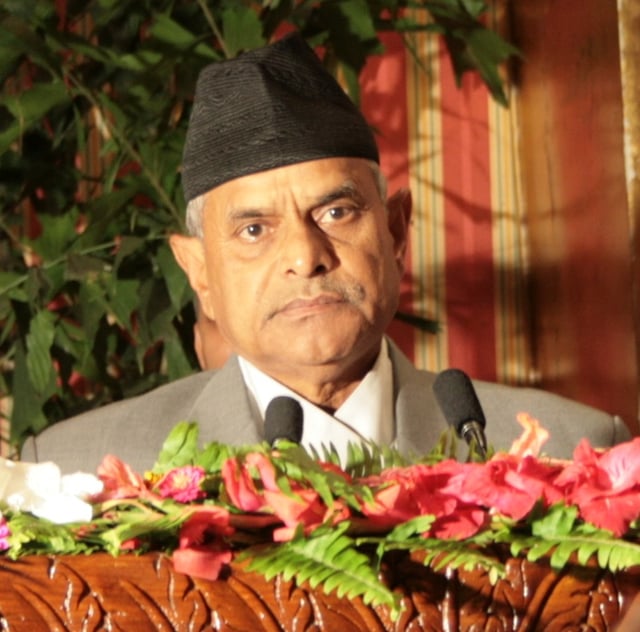
Dr. Ram Baran Yadav, the first President of Nepal
In the late 1940s, newly emerging pro-democracy movements and political parties in Nepal were critical of the Rana autocracy. Meanwhile, with the invasion of Tibet by China in the 1950s, India sought to counterbalance the perceived military threat from its northern neighbour by taking pre-emptive steps to assert more influence in Nepal. India sponsored both King Tribhuvan (ruled 1911–55) as Nepal's new ruler in 1951 and a new government, mostly comprising the Nepali Congress, thus terminating Rana hegemony in the kingdom.[53]
After years of power wrangling between the king and the government, King Mahendra (ruled 1955–72) scrapped the democratic experiment in 1959, and a "partyless" Panchayat system was made to govern Nepal until 1989, when the "Jan Andolan" (People's Movement) forced King Birendra (ruled 1972–2001) to accept constitutional reforms and to establish a multiparty parliament that took seat in May 1991.[57] In 1991–92, Bhutan expelled roughly 100,000 Bhutanese citizens of Nepali descent, most of whom have been living in seven refugee camps in eastern Nepal ever since.[58]
In 1996, the Communist Party of Nepal started a violent bid to replace the royal parliamentary system with a people's republic. This led to the long Nepali Civil War and more than 12,000 deaths. On 1 June 2001, there was a massacre in the royal palace. King Birendra, Queen Aishwarya and seven other members of the royal family were killed. The alleged perpetrator Crown Prince Dipendra, who allegedly committed suicide shortly thereafter, was briefly declared king for three days while he was in coma. Following the carnage, King Birendra's brother Gyanendra inherited the throne. On 1 February 2005, King Gyanendra dismissed the elected government and legislature,assuming full executive powers to quash the violent Maoist movement.[57] But this initiative was unsuccessful because a stalemate had developed in which the Maoists were firmly entrenched in large expanses of countryside but could not yet dislodge the military from numerous towns and the largest cities. In September 2005, the Maoists declared a three-month unilateral ceasefire to negotiate.
In response to the 2006 democracy movement, King Gyanendra agreed to relinquish sovereign power to the people. On 24 April 2006 the dissolved House of Representatives was reinstated. Using its newly acquired sovereign authority, on 18 May 2006 the House of Representatives unanimously voted to curtail the power of the king and declared Nepal a secular state, ending its time-honoured official status as a Hindu Kingdom. On 28 December 2007, a bill was passed in parliament to amend Article 159 of the constitution – replacing "Provisions regarding the King" by "Provisions of the Head of the State" – declaring Nepal a federal republic, and thereby abolishing the monarchy.[59] The bill came into force on 28 May 2008.[60]
Following the declaration of the federal republic, an election was held for the Constituent Assembly that would draft a new constitution.[61] A period of instability followed; with changing governments, and various nationalist movements and popular protests demanding for ethnic autonomy; the political deadlock meant the constituent assembly failed to adopt a constitution within the stipulated time. The Constituent Assembly was dissolved in May 2012.[62] A second election for a new Constituent Assembly was held in 2013 under a non-partisan government led by former Chief Justice Khil Raj Regmi.[63][64] On 25 April 2015, a magnitude 7.8 earthquake struck Nepal[65] followed by a 7.3 magnitude aftershock two weeks later, causing a combined death toll of 8,500, about 21,000 injuries and material loss amounting to a third of the country's annual Gross Domestic Product.[66] The Constitution of Nepal, passed with a 90% majority was announced in 20 September 2015 making Nepal a federal democratic republic divided into seven unnamed provinces. It was, however, rejected by the Madhesi nationalist parties, who intensified their protests, leading to an unofficial economic blockade by the Government of India. By February 2016, an amendment had been agreed between India and Nepal, and the Madhesis slowly backed down after it was passed by parliament.[67][68] The elections for the local, provincial and federal levels of government were held in 2017 and Nepal Communist Party emerged as the ruling party with a strong majority at the federal level, as well as six of the seven provinces.[69]
Geography
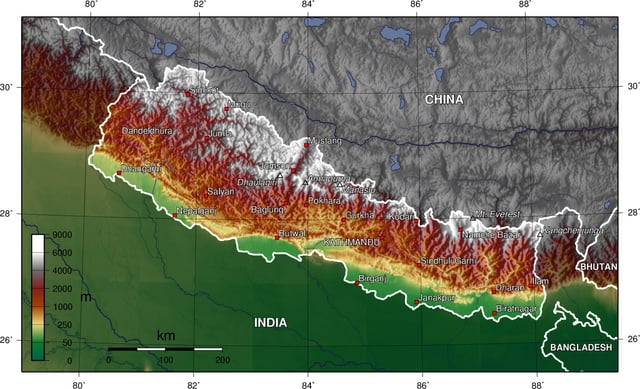
A topographic map of Nepal.
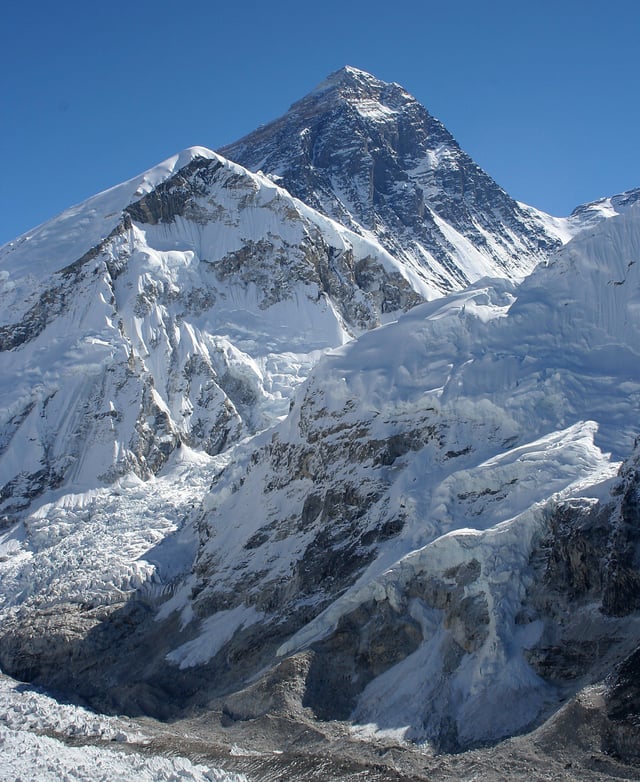
Mount Everest, the highest peak on earth, lies on the Nepal-China border.
Nepal is of roughly trapezoidal shape, about 800 kilometres (500 mi) long and 200 kilometres (120 mi) wide, with an area of 147,181 km2 (56,827 sq mi). It lies between latitudes 26° and 31°N, and longitudes 80° and 89°E. Nepal's defining geological processes began 75 million years ago when the Indian plate, then part of the southern supercontinent Gondwana, began a north-eastward drift caused by seafloor spreading to its south-west, and later, south and south-east.[70] Simultaneously, the vast Tethyn oceanic crust, to its northeast, began to subduct under the Eurasian plate.[70] These dual processes, driven by convection in the Earth's mantle, both created the Indian Ocean and caused the Indian continental crust eventually to under-thrust Eurasia and to uplift the Himalayas.[70] Immediately south of the emerging Himalayas, plate movement created a vast trough that rapidly filled with river-borne sediment[71] and now constitutes the Indo-Gangetic Plain.[72] Nepal lies almost completely within this collision zone, occupying the central sector of the Himalayan arc, nearly one third of the 2,400 km (1,500 mi)-long Himalayas,[73][74][75][76][77][78] with a small strip of southernmost Nepal stretching into the Indo-Gangetic plain and two districts in the northwest stretching up to the Tibetan plateau.
Nepal is divided into three principal physiographic belts known as Himal-Pahad-Terai.[4] Himal is the mountain region containing snow and situated in the Great Himalayan Range; it makes up the northern part of Nepal. It contains the highest elevations in the world including 8,848 metres (29,029 ft) height Mount Everest (Sagarmāthā in Nepali) on the border with China. Seven other of the world's "eight-thousanders" are in Nepal or on its border with China: Lhotse, Makalu, Cho Oyu, Kangchenjunga, Dhaulagiri, Annapurna and Manaslu. Pahad is a mountain region that does not generally contain snow. The mountains vary from 800 to 4,000 metres (2,600 to 13,100 ft) in altitude with progression from subtropical climates below 1,200 metres (3,900 ft) to alpine climates above 3,600 metres (11,800 ft). The Lower Himalayan Range, reaching 1,500 to 3,000 metres (4,900 to 9,800 ft), is the southern limit of this region, with subtropical river valleys and "hills" alternating to the north of this range. Population density is high in valleys but notably less above 2,000 metres (6,600 ft) and very low above 2,500 metres (8,200 ft), where snow occasionally falls in winter. The southern lowland plains or Terai bordering India are part of the northern rim of the Indo-Gangetic Plain. Terai is a lowland region containing some hill ranges. The plains were formed and are fed by three major Himalayan rivers: the Koshi, the Narayani, and the Karnali as well as smaller rivers rising below the permanent snowline. This region has a subtropical to tropical climate. The outermost range of foothills called Sivalik Hills or Churia Range, cresting at 700 to 1,000 metres (2,300 to 3,280 ft), marks the limit of the Gangetic Plain; however broad, low valleys called Inner Tarai Valleys (Bhitri Tarai Uptyaka) lie north of these foothills in several places.
The Indian plate continues to move north relative to Asia at about 50 mm (2.0 in) per year.[79] This makes Nepal an earthquake prone zone, and periodic earthquakes that have devastating consequences present a significant hurdle to the development of Nepal. Erosion of the Himalayas is a very important source of sediment, which flows to the Indian Ocean.[80] Saptakoshi, in particular, carries huge amount of silt out of Nepal but sees extreme drop in Gradient in Bihar, causing severe floods and course changes, and is therefore, known as the sorrow of Bihar. Severe flooding and landslides cause deaths and disease, destroy farmlands and cripple the transport infrastructure of the country, during the monsoon season each year.
Nepal has five climatic zones, broadly corresponding to the altitudes. The tropical and subtropical zones lie below 1,200 metres (3,900 ft), the temperate zone 1,200 to 2,400 metres (3,900 to 7,900 ft), the cold zone 2,400 to 3,600 metres (7,900 to 11,800 ft), the subarctic zone 3,600 to 4,400 metres (11,800 to 14,400 ft), and the Arctic zone above 4,400 metres (14,400 ft). Nepal experiences five seasons: summer, monsoon, autumn, winter and spring. The Himalaya blocks cold winds from Central Asia in the winter and forms the northern limit of the monsoon wind patterns. In a land once thickly forested, deforestation is a major problem in all regions, with resulting erosion and degradation of ecosystems.
Biodiversity
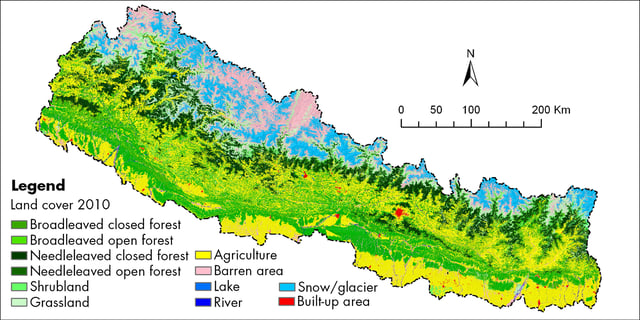
This land cover map of Nepal using Landsat 30 m (2010) data shows forest cover is the dominant type of land cover in Nepal[81]
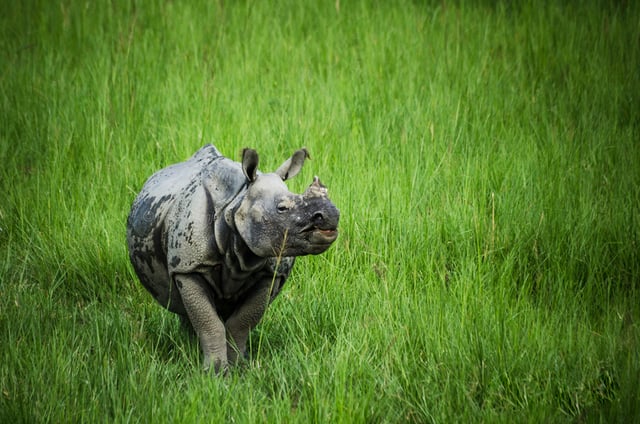
The greater one-horned rhinoceros roams the sub-tropical grasslands of the Terai plains.
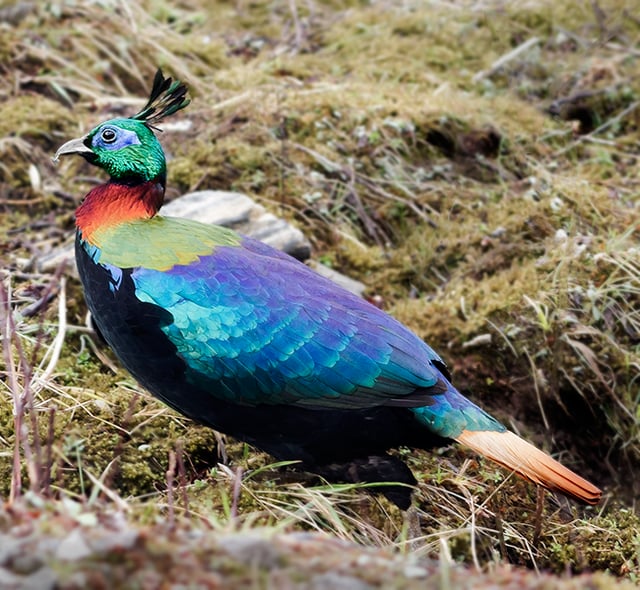
Himalayan monal (Danphe), the national bird of Nepal,[97] nests high in the himalayas
Nepal contains a disproportionately large diversity of plants and animals, relative to its size.[82][83] Nepal, in its entirety, forms the western portion of the eastern Himalayan biodiversity hotspot, with notable biocultural diversity.[84] The dramatic differences in elevation found in Nepal (60 m from sea level in the Terai plains, to 8,848 m Mount Everest)[85] result in a variety of biomes.[82] Eastern half of Nepal is richer in biodiversity as it receives more rain, compared to western parts, where arctic desert-type conditions are more common at higher elevations.[83] Nepal is a habitat for 4.0% of all mammal species, 8.9% of bird species, 1.0% of reptile species, 2.5% of amphibian species, 1.9% of fish species, 3.7% of butterfly species, 0.5% of moth species and 0.4% of spider species.[83] In its 35 forest-types and 118 ecosystems,[82][5] Nepal harbours 2% of the flowering plant species, 3% of pteridophytes and 6% of bryophytes.[83]
Nepal's forest cover is 59,624 km2 (23,021 sq mi), 40.36% of the country's total land area, with an additional 4.38% of scrubland, for a total forested area of 44.74%, an increase of 5% from two decades ago.[86] In the southern plains, Terai-Duar savanna and grasslands ecoregion contains some of the world's tallest grasses, Sal forests, tropical evergreen forests and tropical riverine deciduous forests.[87] In the lower hills (700 m – 2,000 m), subtropical and temperate deciduous mixed forests containing mostly Sal (in the lower altitudes), Chilaune and Katus, as well as subtropical pine forest dominated by Chir pine are common. The middle hills (2,000 m – 3,000 m) are dominated by Oak and Rhododendron. Subalpine coniferous forests cover the 3,000 m to 3,500 m range, dominated by Oak (particularly in the west), Eastern Himalayan fir, Himalyan pine and Himalayan hemlock; Rhododendron is common as well. Above 3,500 m in the west and 4,000 m in the east, coniferous trees give way to Rhododendron-dominated alpine shrubs and meadows.[83]
Among the notable trees that are indigenous to the Indian subcontinent, are the astringent Azadirachta indica, or neem, which is widely used in traditional herbal medicine,[88] and the luxuriant Ficus religiosa, or peepal,[89] which is displayed on the ancient seals of Mohenjo-daro,[90] and under which Gautam Buddha is recorded in the Pali canon to have sought enlightenment.[91] Rhododendron is the national flower of Nepal.[92]
Most of the subtropical evergreen broad-leaved forest of the lower himalayan region is descended from the tethyan tertiary flora.[93] As the Indian plate collided with Eurasia forming and raising the Himalayas, the arid and semi-arid mediterranean flora was pushed up and adapted to the more alpine climate over the next 40–50 million years.[93][94] The Himalayan biodiversity hotspot was the site of mass exchange and intermingling of the Indian and Eurasian species in the neogene.[95] One mammal species (Himalayan field mouse), two each of bird and reptile species, nine amphibian, eight fish and 29 butterfly species are endemic to Nepal.[83][6]
Nepal contains 107 IUCN-designated threatened species, 88 of them animal species, 18 plant species and one species of "fungi or protist" group.[98] These include the endangered Bengal tiger, the Red panda, the Asiatic elephant, the Himalayan musk deer, the Wild water buffalo and the South Asian river dolphin,[99] and the critically endangered Gharial, the Bengal florican,[82][100] and the White-rumped Vulture, which has become nearly extinct by having ingested the carrion of diclofenac-treated cattle.[101] The pervasive and ecologically devastating human encroachment of recent decades has critically endangered Nepali wildlife. In response, the system of national parks and protected areas, first established in 1973 with the enactment of National Parks and Wildlife Conservation Act 1973,[102] was substantially expanded. Vulture restaurants[83] coupled with a ban on veterinary usage of diclofenac has seen a rise in the number of white-rumped vultures.[103][101] The community forestry program which has seen a third of the country's population directly participate in managing a quarter of the total forested area in Nepal, has helped the local economy while reducing human-wildlife conflict.[104][105] The breeding programs[106] coupled with community-assisted military patrols,[107] and a crackdown on poaching and smuggling, has seen poaching of critically endangered tigers and elephants as well as vulnerable rhinos, among others, go down to effectively zero, and their numbers have steadily increased.[108] Nepal has ten national parks, three wildlife reserves, one hunting reserve, three conservation areas and eleven buffer zones, covering a total area of 28,959.67 km2 (11,181.39 sq mi), or 19.67% of the total land area,[109] while ten wetlands are registered under the Ramsar Convention.[110]
Politics and government
Politics
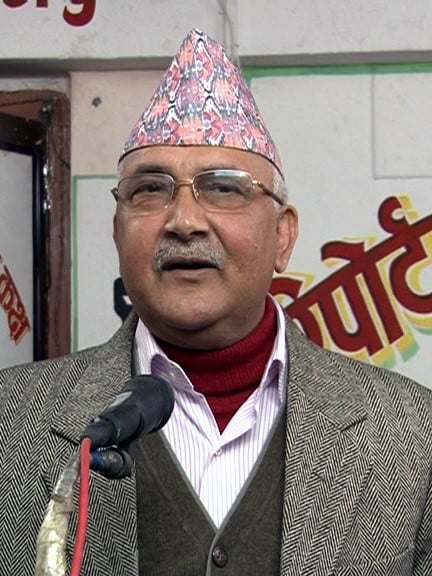
Khadga Prasad Oli, Prime Minister since 15 February 2018
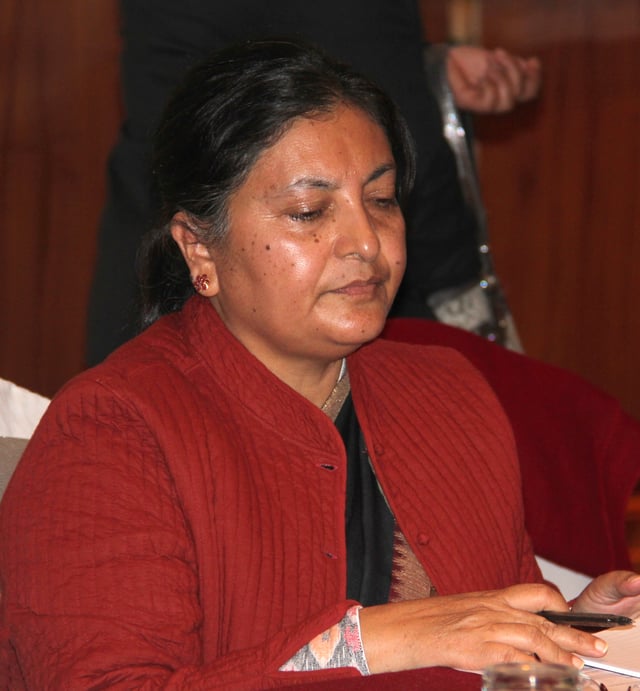
Bidhya Devi Bhandari, President of Nepal since 29 October 2015
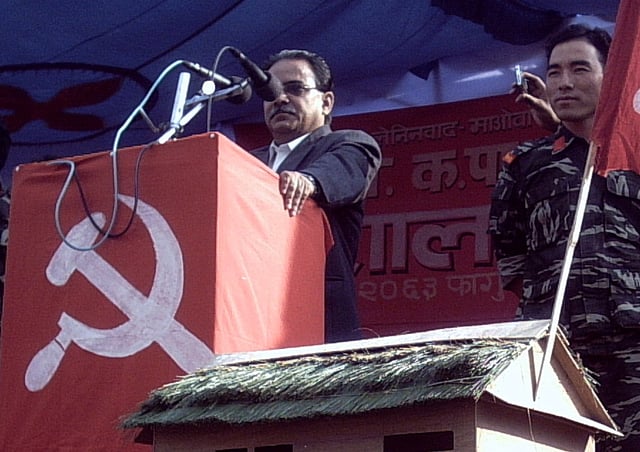
Prachanda speaking at a rally in Pokhara.
Nepal is a parliamentary republic with a multi-party system.[111] It has four political parties recognised in the federal parliament: Nepal Communist Party (NCP), Nepali Congress (NC),[111] Samajbadi Party Nepal (SPN) and Rastriya Janata Party Nepal (RJPN).[111] While all the major parties officially espouse democratic socialism, NCP is considered leftist while Nepali Congress is considered centrist, with most considering it center-left and some center-right.[112] The minor party SPN is leftist and RJPN is center-right to right-wing.[113] During most of the brief periods of democratic exercise between 1950 and 1960 as well as between 1990 and 2001, Nepali Congress held a majority in parliament.[114] Following the entry of the Maoists into the political process, Maoists were the largest party in the first constituent assembly and Nepali Congress were the largest in the second, with no party winning a majority.[115] In the aftermath of the 2017 elections, the first one according to the new constitution, NCP has become the ruling party at the federal level as well as six out of seven provinces.[116] While Nepali Congress has a significantly reduced representation, it is the only major opposition to the ruling communist party in all levels of government.[117]
Early politics in the Kingdom of Nepal was characterised by factionalism, conspiracies and murders, including two major massacres.[7] After almost a century of power-wrangling among the prominent Basnyat, Pande and Thapa families, a fast-rising military leader Janga Bahadur Rana emerged on top in the aftermath of the Kot massacre and established the Rana autocratic regime which consolidated powers of the King as well as prime minister and reigned for another century, with a policy of oppression and isolationism.[118][119] By the 1930s, Nepali expatriates in India had started smuggling in writings on political philosophies, which gave birth to a vibrant underground political movement in the capital, birthing Nepal Praja Parishad in 1939, which was dissolved only two years later following the execution of the four great martyrs. Around the same time, Nepalis involved in the Indian Independence Movement started organising into political parties, leading to the birth of Nepali Congress and Communist Party of Nepal. Following Indian Independence, Nepali Congress was successful in overthrowing the Rana regime with support from the Indian government and cooperation from the king.[120] While communism was still trying to find its footing, Nepali Congress enjoyed overwhelming support of the electorate. Following a brief ten year exercise in democracy, another partyless autocracy was initiated, this time by the King, who deposed the democratically elected government of Nepali Congress, imposed or exiled prominent leaders and issued a ban on party politics.[120][121][122][114]
Many political parties and their leaders remained underground or in exile for the next 30 years of partyless politics in Nepal.[123] BP Koirala was released from prison in 1968 and went into exile in Benaras. Although an armed insurgency launched by the major communist faction called the Jhapa movement had failed comprehensively by 1971, it formed the foundation of the dominant communist power CPN ML that was officially launched in 1978.[124] After the accession of King Birendra generally considered more sympathetic to the wishes of the public, in 1972, the pro-democracy movements picked up steam. BP Koirala returned from exile in 1976, and was immediately put into house arrest.[120] A general referendum was held in 1980, which saw the CPN ML campaign for the option of multi-party democracy, along with Nepali Congress, but the Panchayat System was declared the winner to significant controversy.[122] The Panchayat rule saw governments led by a group of monarchy loyalists taking turns, with Surya Bahadur Thapa, Tulsi Giri and Kirti Nidhi Bista becoming prime minister three times each, among others. The Panchayat system introduced a number of reforms, built infrastructures and modernised the country, while significantly curtailing political freedom, imposing the Nepali language and khas culture to the oppression of all others and spreading Indophobic propaganda the effects of which are experienced up to the present day.[120][114]
In 1990, the joint civil resistance launched by the United left front (an alliance of two major communist parties) and Nepali Congress with pressures created from the economic blockade imposed by India was successful in overthrowing the Panchayat and the country became a constitutional monarchy.[120][125] The United Left Front became CPN UML.[114] The Panchayat loyalists formed National Democratic Party which emerged as the third major party. While Nepali Congress ran the government for most of the next ten years of democracy that followed, democracy was mostly a disappointment owing to the immature democratic culture and political infighting in the capital, as well as the civil war that followed the guerrilla insurgency launched by the Maoist Party. Following a four-year autocratic rule by Gyanendra that failed to defeat the Maoists, a mass civil protest was launched by a coalition of the maoists and the political parties in 2006, which forced the king to stepped down, brought the maoists to the peace process, and established a democratic republic by 2008.[126][127]
Following the political consensus to draft the new constitution of the republic via a constituent assembly, Nepali politics saw a marked increase in forces/ideas of nationalism. While the political power-wrangling caused continuous instability, maintaining the established average of nine months per government, this period saw two constituent assembly elections and the rise of Madhesi nationalist parties, especially in the Eastern Terai region.[115][128][129][130] By 2015, the new constitution had been promulgated and Nepal became "a federal democratic republic striving towards democratic socialism".[131] In 2017, a series of elections were held according to the new constitution, which established Nepal Communist Party (formally united after the election) as the ruling party at the federal level as well as six of the seven provinces, Nepali Congress as the only significant opposition party in federal and provincial levels and the Madhesi coalition formed the provincial government in Province No. 2, but boasts negligible presence in the rest of the country.[132][133][134]
Government
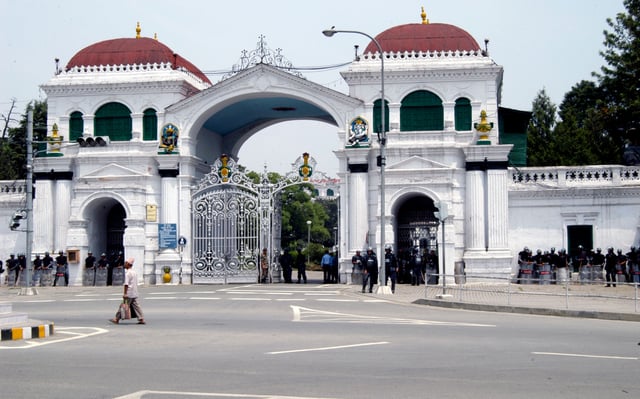
Entrance to Singha Durbar, the seat of the Nepali government in Kathmandu
Nepal is governed according to the Constitution of Nepal, which came into effect on 20 September 2015. It defines Nepal as having multi-ethnic, multi-lingual, multi-religious, multi-cultural characteristics with common aspirations of people living in diverse geographical regions, and being committed to and united by a bond of allegiance to the national independence, territorial integrity, national interest, and prosperity of Nepal. All Nepali people collectively constitute the state.
The Government of Nepal comprises three branches:[30]
Executive: The form of governance of Nepal is a multi-party, competitive, federal democratic republican parliamentary system based on plurality. The executive power of Nepal rests with the Council of Ministers in accordance with the Constitution and Nepali law. The President appoints the parliamentary party leader of the political party with the majority in the House of Representatives as a Prime Minister, and a Council of Ministers is formed in his/her chairmanship. The executive power of the provinces, pursuant to the Constitution and laws, is vested in the Council of Ministers of the province. The executive power of the province shall be exercised by the province Head in case of absence of the province Executive in a State of Emergency or enforcement of Federal rule. Every province has a ceremonial Head as the representative of the Federal government. The President appoints a Governor for every province. The Governor exercises the rights and duties as specified in the constitution or laws. The Governor appoints the leader of the parliamentary party with the majority in the Provincial Assembly as the Chief Minister and the Council of Ministers are formed under the chairpersonship of the Chief Minister.
Legislature: The Legislature of Nepal, called Federal Parliament, consists of two Houses, namely the House of Representatives and the National Assembly. The term of House of Representatives is five years. The House of Representatives consists of 275 members: 165 members elected through the first-past-the-post electoral system consisting of one member from each of the one hundred and sixty five electoral constituencies; 110 elected from proportional representation electoral system where voters vote for parties, while treating the whole country as a single electoral constituency. The National Assembly is a permanent house. The tenure of members of National Assembly is six years. The National Assembly consists of 59 members: 56 members elected from an Electoral College, comprising members of provincial Assembly and chairpersons and vice-chairpersons of Village councils and Mayors and Deputy Mayors of Municipal councils, with different weights of votes for each, with eight members from each province, including at least three women, one Dalit, and one person with a disability or a member of a minority. Three members, including at least one woman, are to be nominated by the President on the recommendation of the Government of Nepal. A Provincial Assembly is the unicameral legislative assembly for a federated province.[135] The term for the Provincial Assembly is five years.
Judiciary: Powers relating to justice in Nepal are exercised by courts and other judicial institutions in accordance with the provisions of the constitution, other laws, and recognised principles of justice. Nepal has a unitary three-tier independent judiciary that comprises the Supreme Court, headed by the Chief Justice of Nepal, 7 High Courts, and a large number of trial courts. The supreme court is the highest court in the land. The high court is the highest court in each province. There are district courts, one in each district below the high courts. The local governments may convene local judicial bodies to resolve disputes and render non-binding verdicts on cases not involving actionable crime. The actions and proceedings of the local judicial bodies may be guided and countermanded by the district courts.[30]
Administrative divisions
Nepal is a federal republic comprising 7 provinces. Each province is composed of 8 to 14 districts. The districts, in turn, comprise local units known as urban and rural municipalities.[30] There is a total of 753 local units which includes 6 metropolitan municipalities, 11 sub-metropolitan municipalities and 276 municipalities for a total of 293 urban municipalities, and 460 rural municipalities.[136] Each local unit is composed of wards. There are 6,743 wards in total.
The local governments enjoy executive and legislative as well as limited judicial powers in their local jurisdiction. The provinces have unicameral parliamentary westminster system of governance. The local and provincial governments exercise some absolute powers and some powers shared with provincial and federal governments as applicable, as listed in the constitution of Nepal. The laws enacted by local governments may not contradict existing laws at the provincial and federal levels or the national constitution. Similarly, provincial legislature may not enact laws contradicting federal laws or the national constitution. The powers not listed in the constitution are exercised by the federal government. The district coordination committee, a committee composed of all elected officials from the local governments in the district, has a very limited role.[30][136]
| No. | Provinces | Capital | Districts | Area (km2) | Population (2011) | Density (people/km2) |
|---|---|---|---|---|---|---|
| 1 | Province No. 1 | Biratnagar | 14 | 25,905 km2 | 4,534,943 | 175 |
| 2 | Province No. 2 | Janakpur | 8 | 9,661 km2 | 5,404,145 | 559 |
| 3 | Province No. 3 | Hetauda | 13 | 20,300 km2 | 5,529,452 | 272 |
| 4 | Gandaki Pradesh | Pokhara | 11 | 21,504 km2 | 2,413,907 | 112 |
| 5 | Province No. 5 | Butwal | 12 | 22,288 km2 | 4,891,025 | 219 |
| 6 | Karnali Pradesh | Birendranagar | 10 | 27,984 km2 | 1,168,515 | 41 |
| 7 | Sudurpashchim Pradesh | Godavari | 9 | 19,539 km2 | 2,552,517 | 130 |
| Total | Nepal | Kathmandu | 77 | 147,181 km2 | 26,494,504 | 180 |
Laws, law enforcement and crime
The Constitution of Nepal is the supreme law of the land, and any other laws contradicting it are automatically invalid to the extent of the contradiction.[137] The specific legal provisions are codified as Civil Code and Criminal Code, accompanied by Civil Procedure Code and Criminal Procedure Code respectively.[138] Other laws may be enacted by the parliament at all levels of government to supplement but not supersede these laws and other laws enacted by the higher level parliaments, as applicable. The Supreme Court is the highest authority in the interpretation of laws and it can direct the parliament to amend or enact new laws as required. Nepali laws are considered generally more progressive compared to other third world countries, and in some instances, some countries of the first world as well. Nepal has abolished the death penalty.[139] It also has made progress in LGBT rights and gender equality. It recognises marital rape and supports abortion rights; however because of the rise in sex-selective abortion, constraints have been introduced. Nepal is a signatory to the Geneva Convention, Conventions/Treaties on the prohibition of Biological, Chemical and Nuclear weapons,[140] International Labour Organisation Fundamental Conventions, Treaty on the non-proliferation of nuclear weapons as well as the Paris climate accord. Some legal provisions that are guided by socio-economic, cultural and religious sensibilities remain discriminatory. There is gender based discrimination against the foreign nationals married to a Nepali citizen. Paternal lineage of a person is valued and required in legal documents. In addition, many laws remain unenforced in practice.
Nepal Police is the primary law enforcement agency of Nepal. It is an independent organisation under the command of the Inspector General of Police, who is appointed by and reports to the Home ministry. Nepal police is responsible for maintaining law and order in the country, which includes police protection and providing security to important public institutions, landmarks and events, prevention of crime and security patrols, search and seizure of contrabands and smuggled goods, investigation and arrest of suspects, maintenance of prison facilities, maintenance of border checkpoints, and carrying out operations and investigations in cooperation with InterPol and police delegates from friendly countries when required. In addition, Nepal Police is also responsible for traffic management in the country, which is done by the special subdivision, the Nepal traffic police force. Nepal Armed Police Force, a separate paramilitary police organisation works in cooperation with Nepal police, assisting the latter in maintaining checkpoints, border security, patrols, crowd control in case of violent protests, security of vital assets, counter-insurgency and anti-terrorism actions, as well as any other internal security matter that requires use of force. The Crime Investigation Department is the special branch of Nepal Police that specialises in criminal investigation and forensic analysis, which maintains an investigative team in every district of the country and is called in when normal police procedures and investigations prove insufficient in resolving a case. The National Investigation Department of Nepal is an independent intelligence organisation which gathers intelligence relevant to internal security and law enforcement, as part of its mandate.[141][142][143][144][145] The Commission for the Investigation of Abuse of Authority is an independent investigative agency that investigates and prosecutes cases related to corruption and bribery, in addition to the abuse of authority by government officials and officeholders.
A 2010 survey estimated about 46,000 hard drug users in the country, with 70% of the users to be within the age group of 15 to 29.[146] There has been a sharp increase in the seizure of drugs such as hashish, heroin and opium in the past few years; and there are indications that drug traffickers are trying to establish Nepal as a transit point.[147] Human trafficking and child labour are major problems in Nepal.[148][149][150] Nepali victims are trafficked within Nepal, to India, the Middle East, and other areas such as Malaysia and forced to become prostitutes, domestic servants, beggars, factory workers, mine workers, circus performers, child soldiers, and others. Sex trafficking is particularly rampant within Nepal and to India, with as many as 5,000 to 10,000 women and girls trafficked to India alone each year.[151][152][153]
Foreign economic and strategic relations
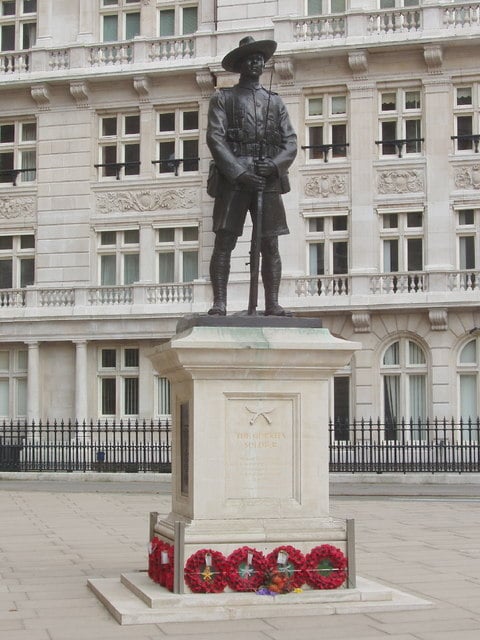
Gurkha Memorial, London
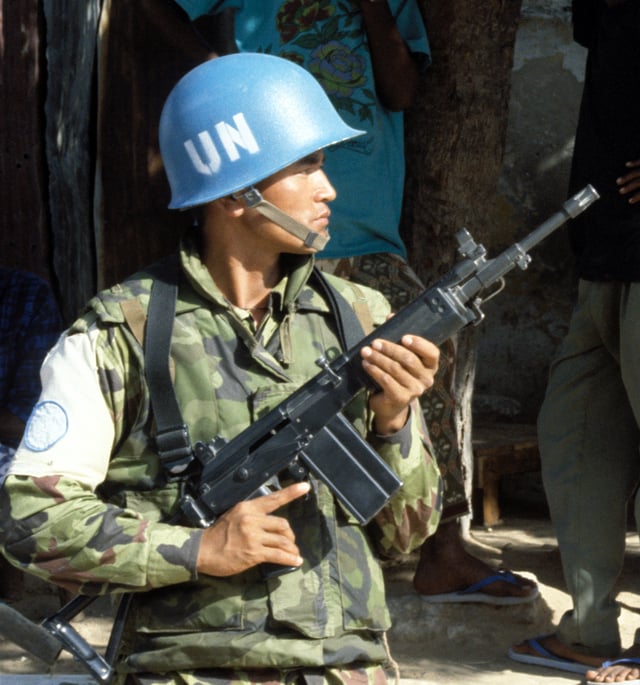
Nepal is one of the major contributor to UN peacekeeping missions.
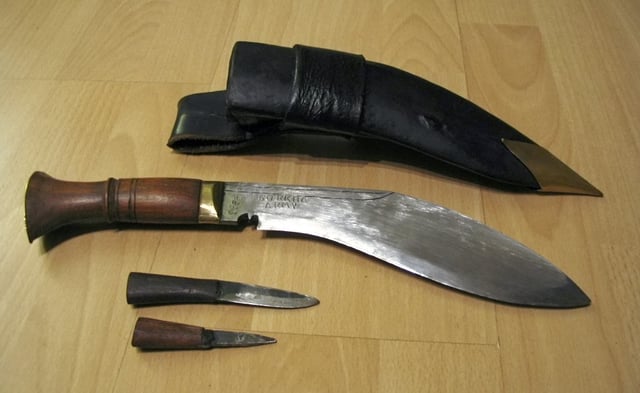
The multipurpose Kukri knife (top) is the signature weapon of Nepali armed forces, and is used by Indian and British Gurkhas, Nepal army, police and even Nepalese security guards.
Nepal pursues a policy of "balanced relations" with the two giant immediate neighbours, India and China,[154][155] although Nepal shares an unparalleled socio-cultural ties with India[156][157] and the Treaty of Peace and Friendship between Nepal and India provides for a much closer relationship between the two countries.[158] Nepal and India share an open border with free movement of people, religious, cultural and marital ties, and each boasts Hindu and Buddhist pilgrimages widely visited by citizens of the other. Nepal's currency is permanently pegged to the Indian currency, most of the third-country trade of Nepal is carried out via Indian ports, and millions of people from Nepal reside in India for education and work, and vice versa. India is Nepal's largest trading partner, and Nepal imports all of its oil and gas, and almost all of a number of other essential supplies including medicine, from India. Nepalis, prominently, participated in the Indian Independence Movement, and India closely monitors and seeks to influence Nepal's internal politics, which has led to India playing indispensable roles in all of Nepal's democratic movements, and on some occasions, India's unwelcome interventions in Nepal's politics has given rise to a significant skepticism regarding India's intentions and strengthened anti-India sentiment in Nepal. Nepalis serve in the Gurkha battalions of the Indian army and have fought in India's wars. Nepalis can own property in India, while Indians are free to live and work in Nepal.[159] While Nepal votes independently in international forums, and India and Nepal often disagree in such votes, Nepal has made a commitment to seek India's approval on any purchase of military weapons from third countries,[160] while India unilaterally considers smaller countries in South Asia including Nepal as under its security sphere, requiring military protection.[161][162] Nepal's long-term grievances against India stem from India's interference in Nepal's internal politics, the 1950 treaty that is seen as unfair to Nepal,[158] alleged border encroachment and harassment by Indian border security force, flooding caused by river dams controlled by India, and India's willingness to blockade Nepal to force its agenda. India has expressed concern with Nepal's apathy toward alleged cross-border terrorism carried out by Pakistani terrorists based in Nepal, Nepal's refusal to acknowledge support for India during India-China conflict and Nepal's recognition of Chinese claim over Tibet, and the alleged use of anti-India propaganda by Nepali political players for political gain, among others.
Nepal established diplomatic relations with the People's Republic of China on 1 August 1955, and relations since have been based on the Five Principles of Peaceful Coexistence. Nepal has always maintained neutrality in conflicts between China and India. It remains firmly committed to the One China Policy, and is known to curb anti-China activities from the Tibetan refugees in Nepal.[163][164] Citizens of both countries can cross the border and travel as far as 30 km without a visa.[165] China is viewed favorably in Nepal because of its assistance in infrastructure development, absence of any border disputes or serious interference in internal politics, aid during natural disasters, and favorability has only increased since China helped Nepal during the economic blockade imposed by India in 2015.[166] Since then, Nepal and China have moved closer on trade and connectivity with China granting Nepal access to its ports for third country trade, and Nepal joining China's ambitious Belt and Road Initiative with plans for expansive road and railway projects.[167]
Nepal emphasizes greater cooperation in the South Asia region and actively pushed for the establishment of SAARC, the South Asian Association for Regional Cooperation, the permanent secretariat of which, is hosted in Kathmandu.[168] Nepal was one of the first countries to recognise an independent Bangladesh, and the two countries seek to enhance greater cooperation, on trade and water management; seaports in Bangladesh which are closer to Nepal, are seen as viable alternatives to India's monopoly on Nepal's third country trade.[169] Nepal's relationship with Bhutan has become acrimonious since Bhutan carried out an ethnic cleansing against its citizens of Nepali origin, in the early 1990s[170] most of the whom have been resettled in third countries after decades of efforts to repatriate them failed.[171] Nepal was the first South Asian country to establish diplomatic relations with Israel, and the countries enjoy a strong relationship.[172] However, Nepal also recognises the rights of the Palestinians, and has voted in favor of recognising Palestine at the UN and against the recognition of Jerusalem as Israel's capital.[173] Other countries that Nepal maintains a close relationship with includes countries that are the most generous donors and development partners of Nepal, namely, the United States, the United Kingdom, Denmark, Japan and Norway, among others.[174]
Nepal's military expenditure for 2018 was $398.5 million,[175] around 1.4% of its GDP.[176] The age of qualification for the military service which is voluntary, is 18 years,[177] The Nepal Army is an almost exclusively ground infantry force, and numbers at less than one hundred thousand,[178][179][180] but also has a few aircraft, mainly helicopters, primarily used for transport, patrol and search and rescue.[181] Directorate of Military Intelligence is the military intelligence agency under Nepal Army,[182] while National Investigation Department is the independent intelligence agency tasked with national and international intelligence gathering.[178] As the military of an underdeveloped small country sandwiched between two superpowers, Nepal Army is not maintained as a national defence force against foreign aggression, but rather for routine security of critical assets, anti-poaching activities in national parks, internal security in times of crisis, like civil war, terrorism, etc. and for search and rescue during natural disasters.[183] Nepal Army also undertakes construction projects.[184] While there are no officially sanctioned discriminatory policies on recruitment to army, except on the basis of physical or mental fitness and age, but rather reservations for marginalised groups,[185] the army is dominated by the elite Pahari warrior castes, women form an abysmal minority[186] and there are allegations of discrimination against sexual minorities,[187] in practice. Nepal mainly depends on diplomacy for national defence. Nepal has always maintained a policy of neutrality between its neighbours, has amicable relations with other countries in the region, and has pursued a policy of non-alignment in the global stage. In addition to the SAARC and the UN, Nepal is also a member of WTO, BIMSTEC and ACD, among others. It conducts joint military exercises with China, India and the United States. Nepal has bilateral diplomatic relations with 167 countries and the EU,[188] has embassies in 30 countries[189] and six consulates,[190] while 25 countries maintain their embassies in Nepal, and more than 80 other countries maintain non-residential diplomatic missions.[191] Nepal is also one of the major contributors to the UN Peacekeeping Missions having contributed more than 119,000 personnel to 42 missions since 1958.[192] Nepali people have a reputation for honesty, loyalty and bravery, which has led to Nepalese citizens serving as the legendary Gurkha warriors in the Indian and British armies for the last 200 years, and have fought in both world wars, India-Pakistan wars as well as being deployed in both Afghanistan and Iraq,[193] even though Nepal wasn't directly involved in any of those conflicts, and have won the highest military awards including the Victoria Cross and the Param Vir Chakra.[194][195] Nepali migrant workers also serve as security guards, and Singapore Police Force also maintains a gurkha contingent of Nepali recruits, owing to the same legendary reputation of the Nepali people.[196][197][198]
Economy
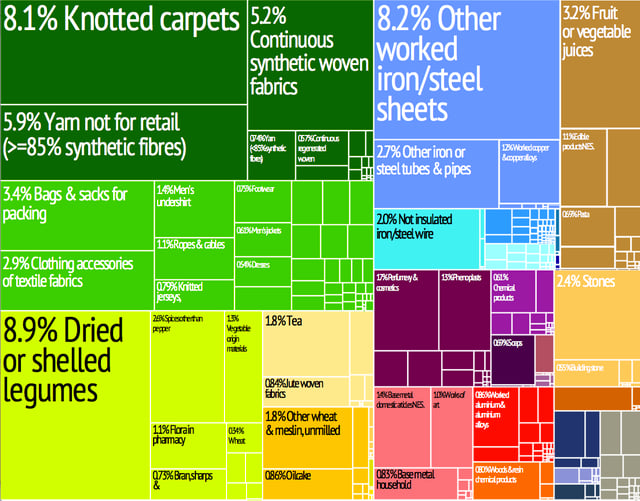
A proportional representation of Nepal's exports.
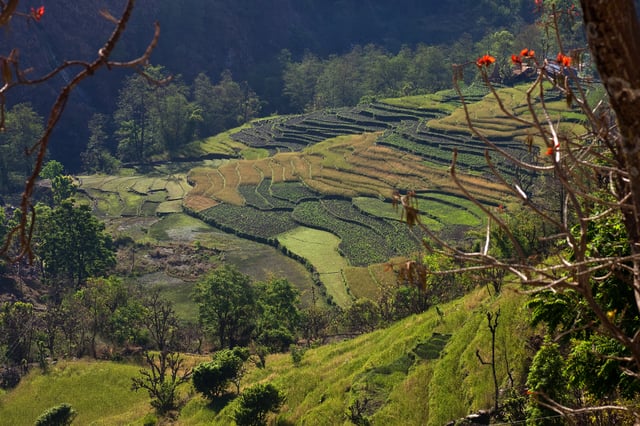
Terraced rice farming in Nepal
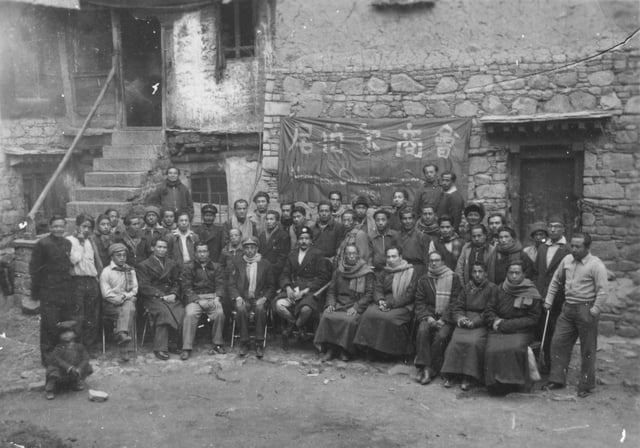
Nepalese Chamber of Commerce, Lhasa, 1955
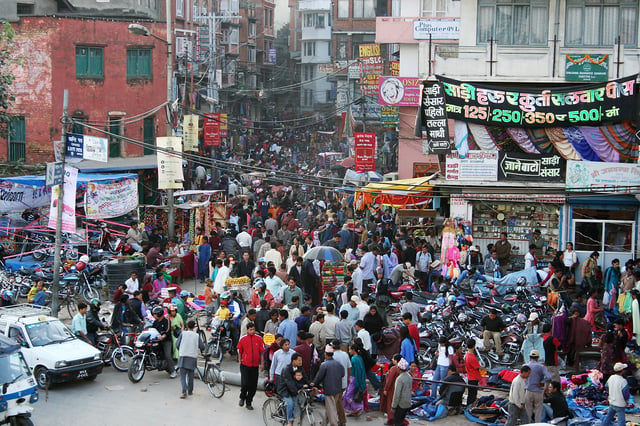
Kathmandu street vendors
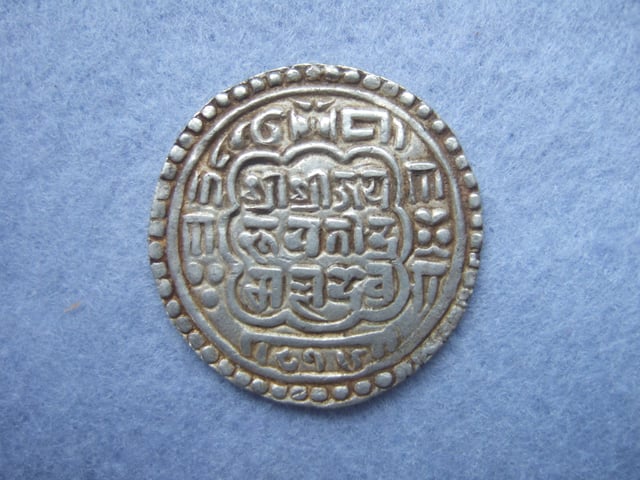
Nepalese silver currency, 1695
Nepal's gross domestic product (GDP) for 2018 was estimated at $28.8 billion.[199] With an annual growth rate of 6.3% in 2018, Nepal is one of the fastest growing economies in the world.[200] In the economic year 2018/19, agriculture accounted for 27.59%, services 57.81%, and industry 14.6% of Nepal's GDP.[201]
Agriculture employs 76% of the workforce, services 18% and manufacturing and craft-based industry 6%. Agricultural produce – mostly grown in the Terai region bordering India – includes tea, rice, corn, wheat, sugarcane, root crops, milk, and water buffalo meat. Industry mainly involves the processing of agricultural produce, including jute, sugarcane, tobacco, and grain. Its workforce of about 10 million suffers from a severe shortage of skilled labour.
Nepal's economic growth continues to be adversely affected by the political uncertainty. Nevertheless, real GDP growth was estimated to increase to almost 5 percent for 2011–2012. This is an improvement from the 3.5 percent GDP growth in 2010–2011 and would be the second-highest growth rate in the post-conflict era.[202] Sources of growth include agriculture, construction, financial and other services. The contribution of growth by consumption fuelled by remittances has declined since 2010/2011. While remittance growth slowed to 11 percent (in Nepali Rupee terms) in 2010/2011, it has since increased to 37 percent. Remittances are estimated to be equivalent to 25–30 percent of GDP. Inflation has been reduced to a three-year low of 7 percent.[202]
The proportion of poor people has declined substantially since 2003. The percentage of people living below the international poverty line (people earning less than US$1.25 per day) has halved in seven years.[202] At this measure of poverty the percentage of poor people declined from 53.1% in 2003/2004 to 24.8% in 2010/2011.[202] With a higher poverty line of US$2 per-capita per day, poverty declined by one-quarter to 57.3%.[202] However, the income distribution remains grossly uneven.[203]
In a recent survey, Nepal has performed extremely well in reducing poverty along with Rwanda and Bangladesh as the percentage of poor dropped to 44.2 percent of the population in 2011 from 64.7 percent in 2006—4.1 percentage points per year, which means that Nepal has made improvement in sectors like nutrition, child mortality, electricity, improved flooring and assets. If the progress of reducing poverty continues at this rate, then it is predicted that Nepal will halve the current poverty rate and eradicate it within the next 20 years.[204][205]
Nepal is popular for mountaineering, having some of the highest and most challenging mountains in the world, including Mount Everest. Technically, the southeast ridge on the Nepali side of the mountain is easier to climb, so most climbers prefer to trek to Everest through Nepal. The spectacular landscape and diverse, exotic cultures of Nepal represent considerable potential for tourism, but growth in the industry has been stifled by political instability and poor infrastructure. Despite these problems, in 2012 the number of international tourists visiting Nepal was 598,204, a 10% increase on the previous year.[206] The tourism sector contributed nearly 3% of national GDP in 2012 and is the second-biggest foreign income earner after remittances.[207]
The rate of unemployment and underemployment approaches half of the working-age population. Thus many Nepali citizens move to other countries in search of work. Destinations include India, Qatar, the United States, Thailand, the United Kingdom, Saudi Arabia, Japan, Brunei Darussalam, Australia, and Canada.[208][209] Nepal receives $50 million a year through the Gurkha soldiers who serve in the Indian and British armies and are highly esteemed for their skill and bravery. As of 2010, the total remittance value is around $3.5 billion.[209] In 2009 alone, the remittance contributed to 22.9% of the country's GDP.[209]
A long-standing economic agreement underpins a close relationship with India. The country receives foreign aid from the UK,[210][211] India, Japan, the US, the EU, China, Switzerland, and Scandinavian countries. Poverty is acute; per-capita income is around $1,000.[212] The distribution of wealth among the Nepali is consistent with that in many developed and developing countries: the highest 10% of households control 39.1% of the national wealth and the lowest 10% control only 2.6%.
The government's budget is about $1.153 billion, with an expenditure of $1.789 billion (FY 20005/06). The Nepali rupee has been tied to the Indian rupee at an exchange rate of 1.6 for many years. Since the loosening of exchange rate controls in the early 1990s, the black market for foreign exchange has all but disappeared. The inflation rate has dropped to 2.9% after a period of higher inflation during the 1990s.
Nepal's exports of mainly carpets, clothing, hemp, leather goods, jute goods and grain total $822 million. Import commodities of mainly gold, machinery and equipment, petroleum products and fertilizer total US$2 billion. European Union (EU) (46.13%), the US (17.4%), and Germany (7.1%) are its main export partners. The European Union has emerged the largest buyer of Nepali ready-made garments (RMG). Exports to the EU accounted for "46.13 percent of the country's total garment exports".[213] Nepal's import partners include India (47.5%), the United Arab Emirates (11.2%), China (10.7%), Saudi Arabia (4.9%), and Singapore (4%).
Besides having landlocked, rugged geography, few tangible natural resources and poor infrastructure, the ineffective post-1950 government and the long-running civil war are also factors in stunting the country's economic growth and development.[214][215][216] Nevertheless, an estimated 234,600 people are enslaved in modern-day Nepal, or 0.82% of the population.[217] Debt bondage even involving debtors' children has been a persistent social problem in the Terai.
Infrastructure
Energy
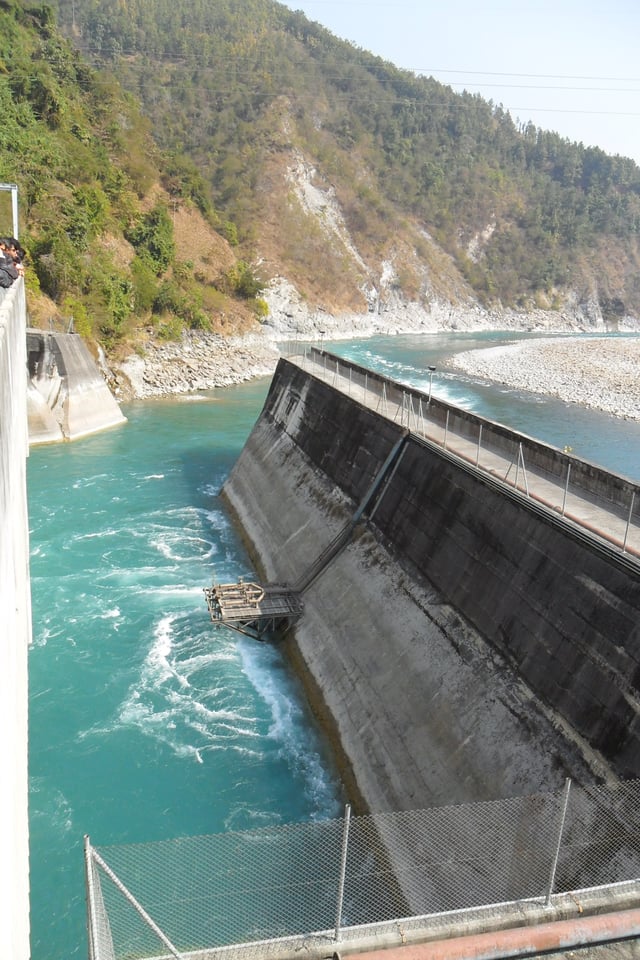
Middle Marshyandi Hydroelectricity Dam. Nepal has significant potential to generate hydropower, which it plans to export across South Asia
The bulk of the energy in Nepal comes from fuel wood (68%), agricultural waste (15%), animal dung (8%), and imported fossil fuels (8%).[218][219] Except for some lignite deposits, Nepal has no known oil, gas or coal deposits. All commercial fossil fuels (mainly oil and coal) are either imported from India or from international markets routed through India and China. Fuel imports absorb over one-fourth of Nepal's foreign exchange earnings.[219] Only about 1% energy need is fulfilled by electricity. The perennial nature of Nepali rivers and the steep gradient of the country's topography provide ideal conditions for the development of hydroelectric projects. Current estimates put Nepal's economically feasible hydropower potential to be approximately 83,000 MW from 66 hydropower project sites.[219][220] However, currently Nepal has been able to exploit only about 600 MW from 20 medium to large hydropower plants and a number of small and micro hydropower plants.[218] There are 9 major hydropower plants under construction, and additional 27 sites considered for potential development.[218] Only about 40% of Nepal's population has access to electricity.[218] There is a great disparity between urban and rural areas. The electrification rate in urban areas is 90%, whereas the rate for rural areas is only 5%.[219] The peak electricity demand is almost double the capability or dependable capacity in winter season.[221] The position of the power sector remains unsatisfactory because of high tariffs, high system losses, high generation costs, high overheads, over staffing, and lower domestic demand.[219]
Transport
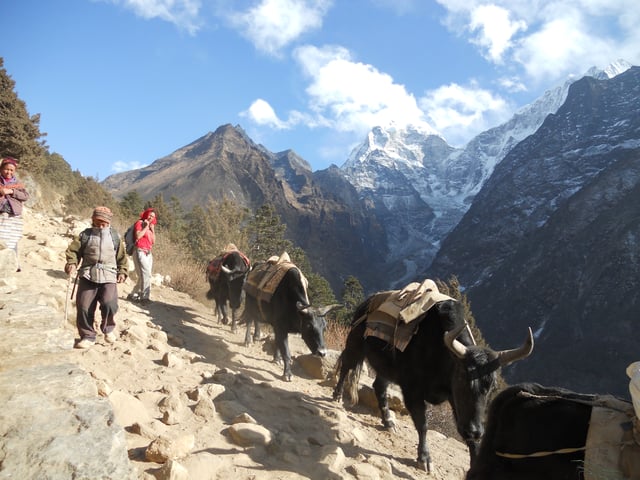
Means of transport in mountainous area
Nepal remains isolated from the world's major land, air and sea transport routes although, within the country, aviation is in a better state, with 47 airports, 11 of them with paved runways;[222] flights are frequent and support a sizeable traffic. The hilly and mountainous terrain in the northern two-thirds of the country has made the building of roads and other infrastructure difficult and expensive. In 2007 there were just over 10,142 km (6,302 mi) of paved roads, and 7,140 km (4,437 mi) of unpaved road, and one 59 km (37 mi) railway line in the south.[222]
More than one-third of its people live at least a two hours walk from the nearest all-season road. Only recently all district headquarters (except for Simikot and Dunai) became reachable by road from Kathmandu. In addition, around 60% of the road network and most rural roads are not operable during the rainy season.[223] The only practical seaport of entry for goods bound for Kathmandu is Kolkata in West Bengal state of India. Internally, the poor state of development of the road system makes access to markets, schools, and health clinics a challenge.[214]
Education
The overall literacy rate (for population age 5 years and above) increased from 54.1% in 2001 to 65.9% in 2011. The male literacy rate was 75.1% compared to the female literacy rate of 57.4%. The highest literacy rate was reported in Kathmandu district (86.3%) and lowest in Rautahat (41.7%).[18] While the net primary enrolment rate was 74% in 2005;[224] in 2009, that enrolment rate was 90%.[225]
However, increasing access to secondary education (grade 9–12) remains a major challenge, as evidenced by the low net enrolment rate of 24% at this level. More than half of primary students do not enter secondary schools, and only one-half of them complete secondary schooling. In addition, fewer girls than boys join secondary schools and, among those who do, fewer complete the 10th grade.[226] On the other hand, citing poor university education at home, tens of thousands of Nepali students leave the country every year, with half of them never returning.[227][228]
Nepal has seven universities: Tribhuvan University, Kathmandu University, Pokhara University, Purbanchal University, Mahendra Sanskrit University, Far-western University, and Agriculture and Forestry University.[229] Some newly proposed universities are Lumbini Bouddha University, and Mid-Western University. Some fine scholarship has emerged in the post-1990 era.[230]
Health
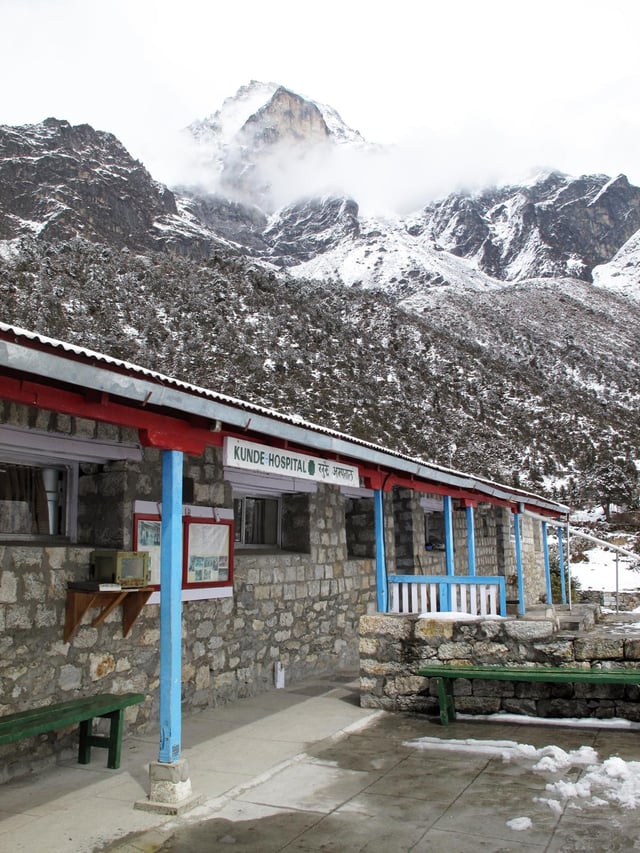
Kunde Hospital in remote Himalayan region
Public health and health care services in Nepal are provided by both the public and private sectors. According to 2011 census, more than one-third (38.17%) of the total households do not have a toilet.[18] Tap water is the main source of drinking water for 47.78% of households, tube well/hand pump is the main source of drinking water for about 35% of households, while spout, uncovered well/kuwa, and covered well/kuwa are the main source for 5.74%, 4.71%, and 2.45% respectively.[18] Based on 2010 World Health Organization (WHO) data, Nepal ranked 139th in life expectancy in 2010 with the average Nepali living to 65.8 years.[231][232] Leading sicknesses include gastrointestinal diseases (especially diarrhea and intestinal parasites), goiter, leprosy, visceral leishmaniasis and tuberculosis.[233] About 4 out of 1,000 adults aged 15 to 49 had human immunodeficiency virus (HIV), and the HIV prevalence rate was 0.5%.[234][235] Malnutrition also remains very high: about 47% of children under five are stunted, 15 percent wasted, and 36 percent underweight, although there has been a declining trend for these rates over the past five years, they remain alarmingly high.[236] In spite of these figures, improvements in health care have been made, most notably in maternal-child health. In 2012, the under-five infant mortality was estimated to be 41 out of every 1000 children.[237][238] Overall Nepal's Human Development Index (HDI) for health was 0.77 in 2011, ranking Nepal 126 out of 194 countries, up from 0.444 in 1980.[239][240]
Telecommunications and mass media
According to the Nepal Telecommunication Authority MIS May 2012 report,[241] there are seven operators and the total voice telephony subscribers including fixed and mobile are 16,350,946, which gives a penetration rate of 61.42%. The fixed telephone service account for 9.37%, mobile for 64.63%, and other services (LM, GMPCS) for 3.76% of the total penetration rate. Similarly, the numbers of subscribers to data/internet services are 4,667,536, which represents 17.53% penetration rate. Most of the data service is accounted by GPRS users. Twelve months earlier the data/internet penetration was 10.05%, thus this represents a growth rate of 74.77%.[241]
Not only has there been strong subscriber growth, especially in the mobile sector, but there was evidence of a clear vision in the sector, including putting a reform process in place and planning for the building of necessary telecommunications infrastructure. Most importantly, the Ministry of Information and Communications (MoIC) and the telecom regulator, the National Telecommunications Authority (NTA), have both been very active in the performance of their respective roles.[242]
Despite all the effort, there remained a significant disparity between the high coverage levels in the cities and the coverage available in the underdeveloped rural regions. Progress on providing some minimum access had been good. Of a total of 3,914 village development committees across the country, 306 were unserved by December 2009.[242] In order to meet future demand, it was estimated that Nepal needed to invest around US$135 million annually in its telecom sector.[242] In 2009, the telecommunication sector alone contributed to 1% of the country's GDP. [232] As of 30 September 2012, Nepal has 1,828,700 Facebook users.[244]
As of 2007, the state operates two television stations as well as national and regional radio stations. There are roughly 30 independent TV channels registered, with only about half in regular operation. Nearly 400 FM radio stations are licensed with roughly 300 operational.[222] According to the 2011 census, the percentage of households possessing radio was 50.82%, television 36.45%, cable TV 19.33%, computer 7.23%.[18] According to the Press Council Nepal, as of 2012 there are 2,038 registered newspapers in Nepal, among which 514 are in publication.[245] In 2013, Reporters Without Borders ranked Nepal at 118th place in the world in terms of press freedom.[246][247]
Demographics

Comparison Of Nepal Population

Population density map of Nepal
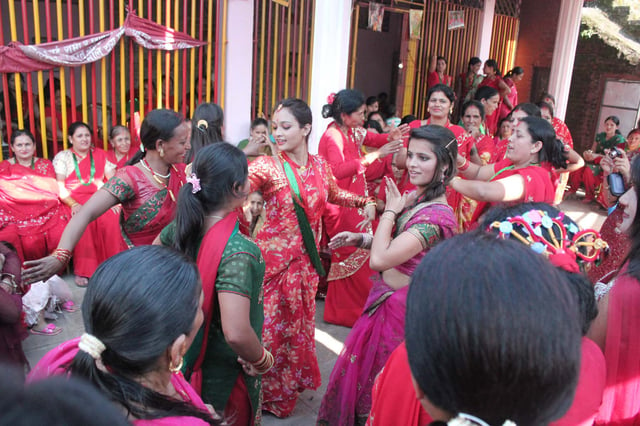
Nepalese women dancing for Teej
According to the 2011 census, Nepal's population grew from 9 million people in 1950 to 26.5 million. From 2001 to 2011, the average family size declined from 5.44 to 4.9. The census also noted some 1.9 million absentee people, over a million more than in 2001; most are male labourers employed overseas, predominantly in South Asia and the Middle East. This correlated with the drop in sex ratio from 94.41 as compared to 99.80 for 2001. The annual population growth rate is 1.35%.[18]
The citizens of Nepal are known as Nepali or Nepalese. The country is home to people of many different national origins. As a result, Nepalese do not equate their nationality with ethnicity, but with citizenship and allegiance. Although citizens make up the majority of Nepalese, non-citizen residents, dual citizens, and expatriates may also claim a Nepalese identity. Nepal is multicultural and multiethnic country. The Nepali are descendants of three major migrations from India, Tibet, and North Burma and the Chinese province of Yunnan via Assam. Among the earliest inhabitants were the Kirat of east mid-region, Newars of the Kathmandu Valley, aboriginal Tharus of the Terai plains.
Despite the migration of a significant section of the population to the Terai in recent years, the majority of Nepalese still live in the central highlands; the northern mountains are sparsely populated. Kathmandu is the largest city in the country and the cultural and economic heart.
According to the World Refugee Survey 2008, published by the US Committee for Refugees and Immigrants, Nepal hosted a population of refugees and asylum seekers in 2007 numbering approximately 130,000. Of this population, approximately 109,200 persons were from Bhutan and 20,500 from People's Republic of China.[248][249] The government of Nepal restricted Bhutanese refugees to seven camps in the Jhapa and Morang districts, and refugees were not permitted to work in most professions.[248] At present, the United States is working towards resettling more than 60,000 of these refugees in the US.[58]
| Data | Size |
|---|---|
| Population | 26,494,504 (2011) |
| Growth rate | 1.35% |
| Population below 14 Years old | 34.19% |
| Population of age 15 to 59 | 54.15% |
| Population above 60 | 8.13% |
| Median age (average) | 20.07 |
| Median age (male) | 19.91 |
| Median age (females) | 20.24 |
| Ratio (male:female) | 100:94.16 |
| Life expectancy (average) (reference:[250]) | 66.16 Years |
| Life expectancy (male) | 64.94 |
| Life expectancy (female) | 67.44 |
| Literacy rate (average) | 65.9% |
| Literacy rate (male) | 75.1% |
| Literacy rate (female) | 57.4% |
Languages
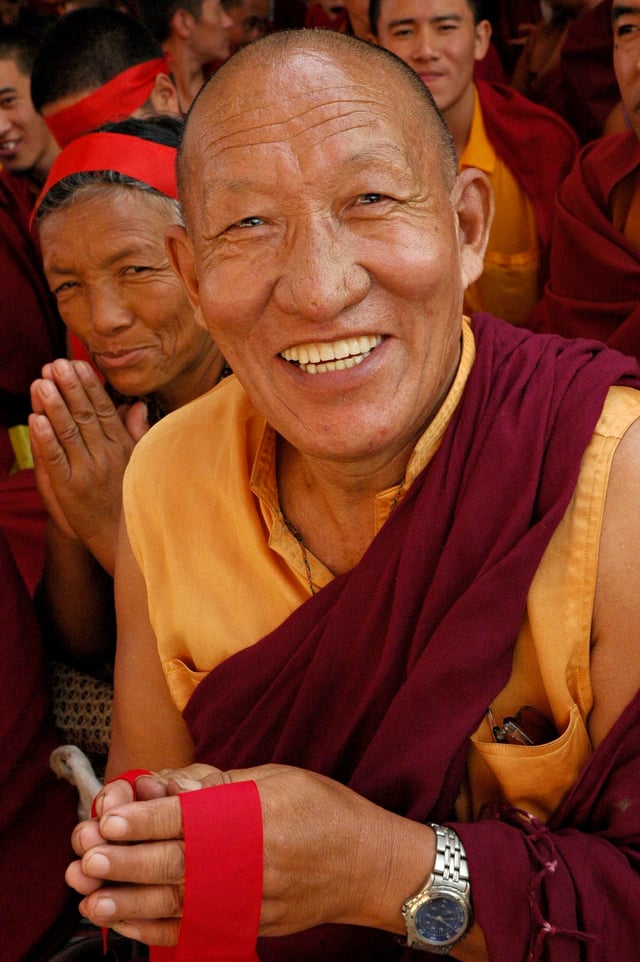
A Nepalese Tibetan monk
Nepal's diverse linguistic heritage stems from three major language groups: Indo-Aryan, Tibeto-Burman, and various indigenous language isolates. The major languages of Nepal (percent spoken as native language) according to the 2011 census are Nepali (44.6%), Maithili (11.7%), Bhojpuri (6.0%), Tharu (5.8%), Tamang (5.1%), Nepal Bhasa (3.2%), Bajjika (3%) and Magar (3.0%), Doteli (3.0%), Urdu (2.6%), Awadhi (1.89%), and Sunwar. Nepal is home to at least four indigenous sign languages.
Descendent of Sanskrit, Nepali is written in Devanagari script. It is the official language and serves as lingua franca among Nepali of different ethnolinguistic groups. The regional languages Maithili, Awadhi and Bhojpuri are spoken in the southern Terai region; Urdu is common among Nepali Muslims. Varieties of Tibetan are spoken in and north of the higher Himalaya where standard literary Tibetan is widely understood by those with religious education. Local dialects in the Terai and hills are mostly unwritten with efforts underway to develop systems for writing many in Devanagari or the Roman alphabet.
Religion

Sadhus in Pashupatinath Temple
The 2011 census reported that the religion with the largest number of followers in Nepal was Hinduism (81.3% of the population), followed by Buddhism (9%); the remaining were Islam (4.4%), Kirant (3%), Christianity (1.3%) and other folk religions (0.4%). The prevalence of irrelegion was reported to be at 0.5%.[12] By percentage of population, Nepal has the largest population of Hindus in the world.[251] Nepal was officially a Hindu Kingdom until recently, and Shiva was considered the guardian deity of the country.[252] Differences between Hindus and Buddhists have been minimal in Nepal due to the cultural and historical intermingling of Hindu and Buddhist beliefs. Important pilgrimages in Nepal include, Pashupatinath Temple, Lumbini (the birthplace of Gautam Buddha) and Janakpurdham (the site of the ancient capital of Videha, home to goddess Sita), among others.
Urbanisation
As Nepal is one of the developing countries, its cities, like other aspects, are growing. More than 20% of the population live in urban areas. The capital, Kathmandu, is the largest city and is called the "City of Temples" for its numerous temples of Hindu and Buddhist gods and goddess. One of the oldest cities of South Asia, Katmandu has five UNESCO World Heritage Sites, palaces and historically important sites such as Singha Durbar. The other large cities of Nepal are Pokhara, Biratnagar, Lalitpur, Bharatpur, Birgunj, Dharan, Hetauda and Nepalgunj.
Culture
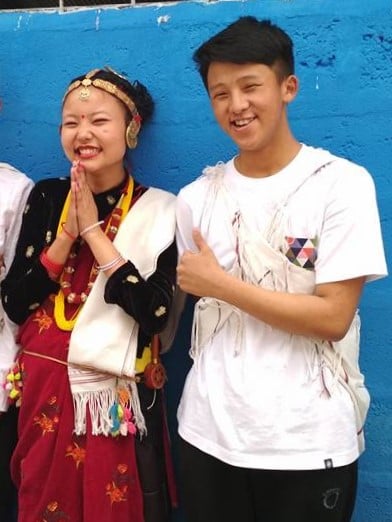
A Magar couple in their ethnic dress.
Folklore is an integral part of Nepali society. Traditional stories are rooted in the reality of day-to-day life, tales of love, affection and battles as well as demons and ghosts and thus reflect local lifestyles, culture, and beliefs. Many Nepali folktales are enacted through the medium of dance and music.
Most houses in the rural lowlands of Nepal are made up of a tight bamboo framework and walls of a mud and cow-dung mix. These dwellings remain cool in summer and retain warmth in winter. Houses in the hills are usually made of unbaked bricks with thatch or tile roofing. At high elevations construction changes to stone masonry and slate may be used on roofs.
Nepal's flag is the only national flag in the world that is not rectangular in shape.[253] The constitution of Nepal contains instructions for a geometric construction of the flag.[254] According to its official description, the red in the flag stands for victory in war or courage, and is also the colour of the rhododendron, the national flower of Nepal. Red also stands for aggression. The flag's blue border signifies peace. The curved moon on the flag is a symbol of the peaceful and calm nature of Nepali, while the sun represents the aggressiveness of Nepali warriors.
Architecture
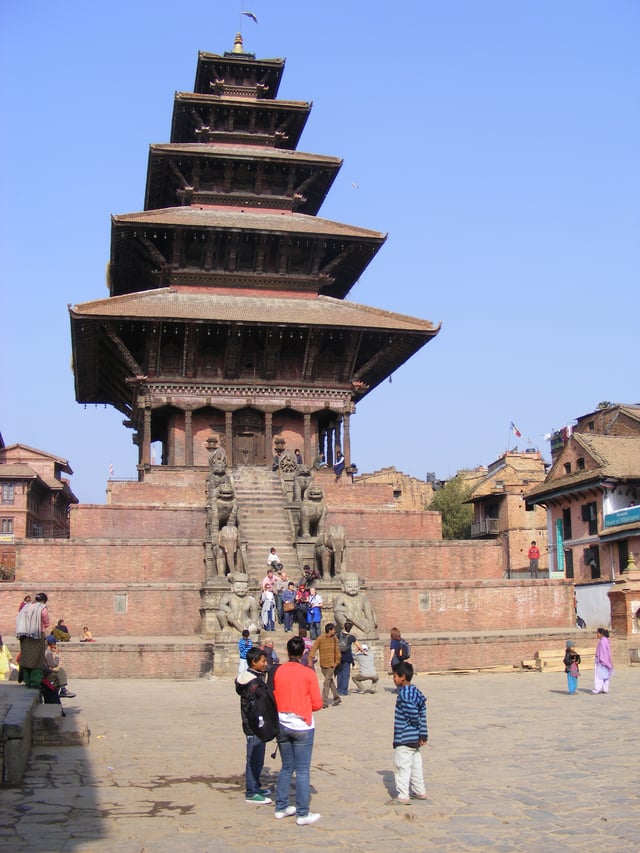
Nyatapola was erected by King Bhupatindra Malla in 1702 and is a major tourist attraction in the historical city of Bhaktapur.
Historical kingdoms that existed in the Kathmandu valley are found to have made use of some clever technologies in numerous areas such as architecture, agriculture, civil engineering, water management, etc. The Gopals and Abhirs, who ruled the valley up until c. 1000 BC, used temporary materials for construction such as bamboo, hay, timber, etc. The Kirat period (700 BC – 110 AD) employed the technology of brick firing as well as produced quality woolen shawls. Similarly, stupas, idols, canals, self-recharging ponds, reservoirs, etc. constructed during the Lichhavi era (110–879 AD) are intact to this day, which manifests the ingenuity of traditional architecture. Moreover, the Malla period (1200–1768 AD) saw an impressive growth in architecture, on par with its advanced contemporaries. An archetypal example of Malla architecture is Nyatapola, a five-storied, 30-metre tall temple in Bhaktapur, which has strangely survived at least four major earthquakes, including the April 2015 Nepal earthquake.[255]
Holidays and festivals
With 15 days a year, Nepal is the country that enjoys the least number of public holidays in the world.[256] The Nepali year begins in 1st of Baisakh in official Hindu Calendar of the country, the Bikram Sambat, which falls in mid-April and is divided into 12 months. Saturday is the official weekly holiday. Main annual holidays include the Martyr's Day (18 February), and a mix of Hindu and Buddhist festivals such as Dashain in autumn, Tihar in mid-autumn and Chhath in late autumn. During Swanti, the Newars perform the Mha Puja ceremony to celebrate New Year's Day of the lunar calendar Nepal Sambat. Being a Secular country Nepal has holiday on main festivals of minority religions too.[257]
Cuisine
The national cuisine of Nepal is Dhindo and Gundruk.The staple Nepali meal is dal bhat. Dal is a lentil soup, and is served over bhat (boiled rice), with tarkari (curried vegetables) together with achar (pickles) or chutni (spicy condiment made from fresh ingredients). It consists of non-vegetarian as well as vegetarian items. Mustard oil is a common cooking medium and a host of spices, including cumin, coriander, black pepper, sesame seeds, turmeric, garlic, ginger, methi (fenugreek), bay leaves, cloves, cinnamon, chilies and mustard seeds are used in cooking. Momo is a type of steamed dumpling with meat or vegetable fillings, and is a popular fast food in many regions of Nepal.
Sports
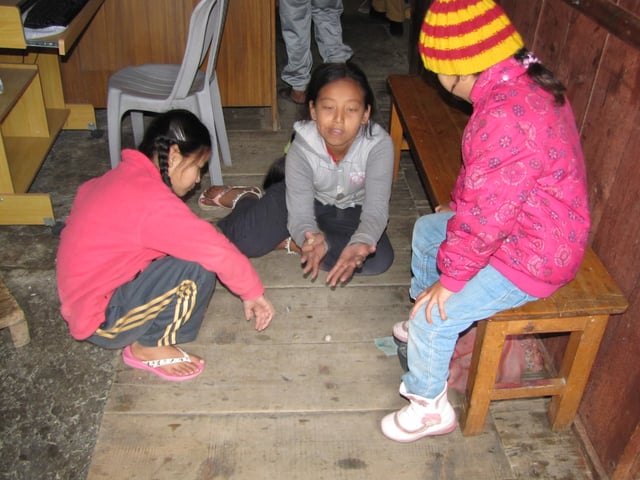
Nepali children playing a variant of knucklebones with pebbles.
Nepali indigenous sports, like dandi biyo and kabaddi which were considered the unofficial national sports until recently,[258] are still popular in rural areas.[259] Despite various efforts, standardisation and development of dandi biyo has not been achieved,[260][261] while Kabaddi, as a professional sport, is still in its infancy in Nepal.[262] Bagh-chal, an ancient board game that's thought to have originated in Nepal, can be played on chalk-drawn boards, with pebbles, and is still popular today.[263][264] Ludo, snakes and ladders and carrom are popular pastimes.[265] Chess is also played.[259] Volleyball was declared as the national sport of Nepal in 2017.[258] Popular children's games include versions of tag,[259] knucklebones,[8][259] hopscotch,[9] Duck, duck, goose[259] and lagori, while marbles,[259] top,[10] hoop rolling and gully cricket are also popular among boys. Rubber bands, or ranger bands cut from bike tyres, make a multi-purpose sporting equipment for Nepali children, which may be bunched or chained together, and used to play dodgeball, cat's cradle, jianzi[11][259] and a variety of skipping rope games.[259]
Football and cricket are popular professional sports.[268] Nepal is competitive in football in the South Asia region but has never won the SAFF championships, the regional tournament.[269][270] It usually ranks in the bottom quarter in the FIFA world rankings.[271] Nepal has had success in cricket and holds the elite ODI status,[272][273] consistently ranking in the Top 20 in the ICC ODI and T20I rankings.[274][275] Nepal has had some success in athletics and martial arts, having won many medals at the South Asian Games and some at the Asian games.[276] Nepal has never won an olympic medal.[277] Sports like basketball, volleyball, futsal, wrestling, competitive bodybuilding[277][278] and badminton are also gaining in popularity.[259] Women in football, cricket, athletics, martial arts, badminton and swimming have found some success.[279][277] Nepal also fields players and national teams in several tournaments for the differently abled, most notably in men's[280] as well as women's blind cricket.[281]
The only international stadium in the country is the multi-purpose Dasarath Stadium where the men and women national football teams play their home matches.[282] Since the formation of the national team, Nepal has played its home matches of cricket at Tribhuvan University International Cricket Ground.[283] Nepal police, Armed police force and Nepal army are the most prolific producers of national players, and aspiring players are known to join armed forces, for the better sporting opportunities they can provide.[284][285] Nepali sports is hindered by a lack of infrastructure,[286] funding,[280] corruption, nepotism and political interference.[276][287][288] Very few players are able to make a living as professional sportspeople.[282]
See also
Outline of Nepal
